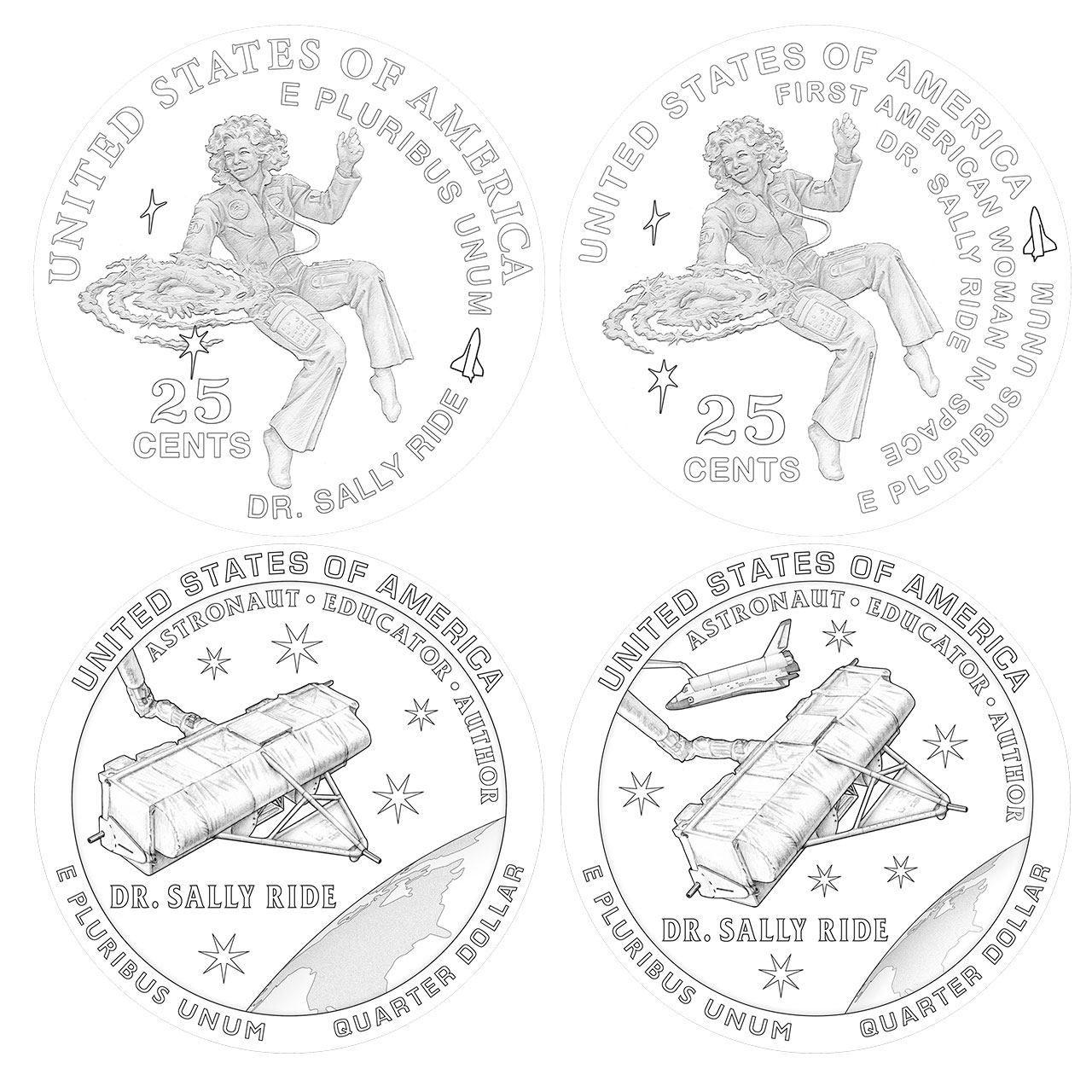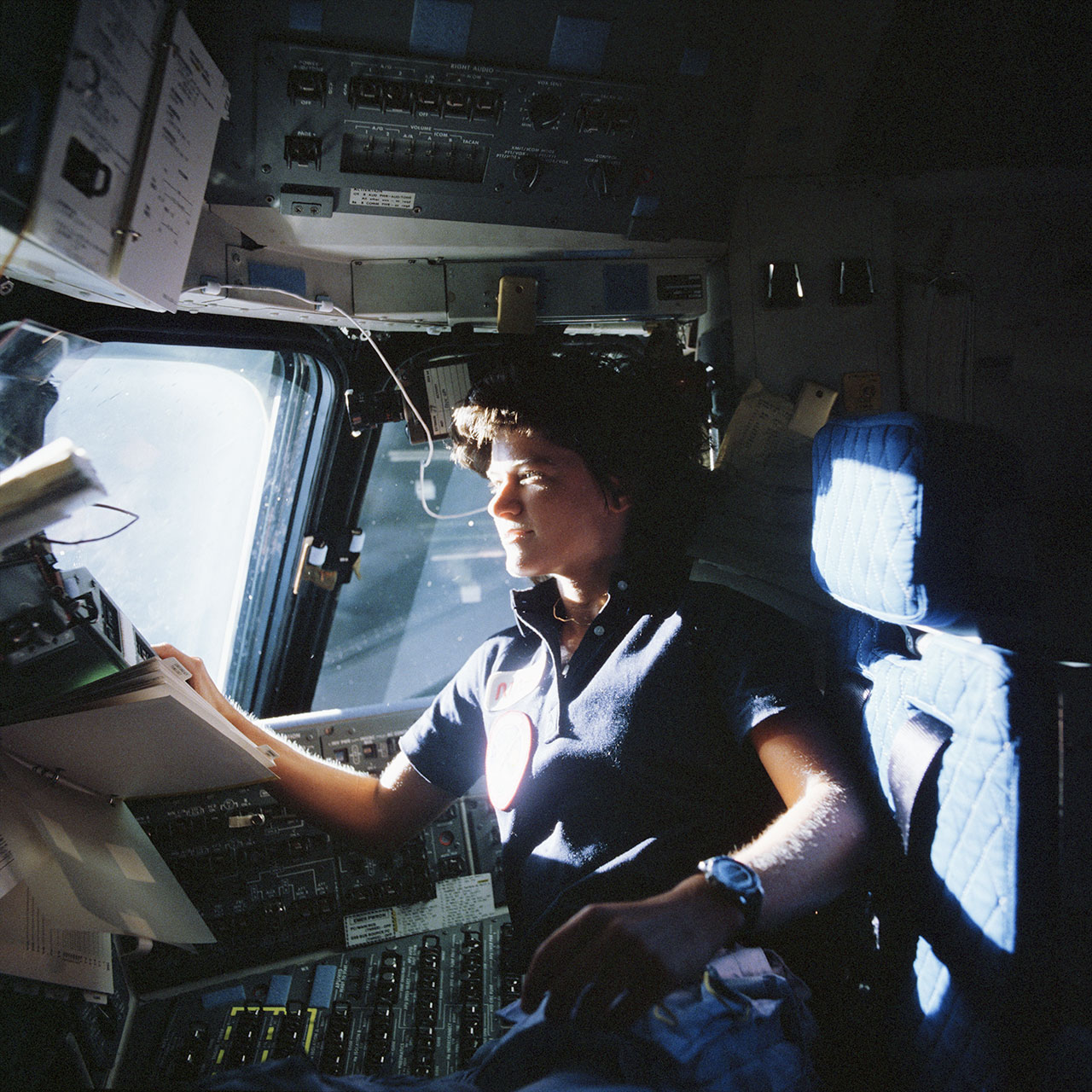Sally Ride coin designs recommended for 2022 American Women quarter
The leading design shows Ride looking out a spacecraft window at Earth.

Astronaut Sally Ride will be depicted on a U.S. coin looking out a spacecraft window at Earth, if the U.S. Secretary of the Treasury agrees with the recommendations made by two advisory panels for the design of quarter dollar to be issued in 2022.
The Citizens Coinage Advisory Committee (CCAC) met virtually Tuesday (April 20) to review, in part, the United States Mint's concepts for the coin honoring the first American woman in space as part of the new American Women Quarters program starting next year. The CCAC meeting followed a similar review by the U.S. Commission of Fine Arts held on April 15.
Both groups favored a design showing Ride on the space shuttle Challenger, on her first NASA mission, STS-7, in 1983. The artwork, one of five proposals created by the Mint's artists, was also the stated choice of Tam O'Shaughnessy, Ride's life partner and executive director of Sally Ride Science, a non-profit started by the late astronaut to promote an interest among young girls in science and technology.
Sally Ride: The first American woman in space

"This design depicts Dr. Sally Ride next to a window on the space shuttle inspired by her quote, 'But when I wasn't working, I was usually at a window looking down at Earth,'" April Stafford, director of the Office of Design Management for the U.S. Mint, told the 10 members of the CACC. "The placement of 'E Pluribus Unum' is intentionally positioned over the Earth, next to America, indicating that out of all of the women in the United States, Dr. Ride was the first into space."
"E pluribus unum" is Latin for "out of many, one" and is a traditional motto of the United States.
"I rather enjoy the symbolism of the 'E Pluribus Unum' [inscription] and what it represents in the context of this coin," said Peter van Alfen, chief curator for the American Numismatic Society and a CCAC member.
Breaking space news, the latest updates on rocket launches, skywatching events and more!
The design was considered alongside two pairs of similar concepts, one showing Ride floating in zero gravity symbolically handing off a spiral galaxy to the coin's holder representing her work in education and another omitting Ride but depicting the first Shuttle Pallet Satellite, SPAS-1, which was deployed from Challenger on Ride's STS-7 mission.
Prior to the meeting, members of the Smithsonian's staff offered their preference for designs showing Ride.
"I do think it's really important when honoring the woman to have the woman on the coin," said Robin Salmon, vice president of art and historical collections and curator of sculpture at Brookgreen Gardens in South Carolina.

Several panel members also liked the designs showing Ride floating in space, but felt the art might be more appropriate for a different type of coin or medal, that it might not be sufficiently reverent to its subject or that it could become indiscernible when shrunk down to fit on the reverse (or tail's side) of a quarter.
"The whimsical ones were just too cute," said Mary Lannin, chair of the CCAC. "It didn't really show anything, it didn't tell anything."
The committee debated the inclusion of Ride's title ("Dr.") on their chosen design, but ultimately left that decision to the Mint, and briefly discussed a request made by O'Shaughnessy to add an additional inscription to the artwork noting Ride's different roles as an "astronaut, educator and author" (as included on some of the other concepts).
"That would be a tough challenge," Ron Harrigal, acting quality manager at the U.S. Mint, told the panel. "The amount of real estate that's already taken up by the inscriptions would make that quite a difficult task, as far as I am concerned."
NASA's space shuttle program in pictures: A tribute
The Commission of Fine Arts also raised a question about the patch depicted on Ride's flight suit. Many of the CCAC members agreed that the emblem should be a period-correct NASA insignia, which turned out to already be the case.
"The patch for STS-7, which was the Challenger space shuttle mission that Sally Ride first flew on, showed a view of the Challenger head-on with this five-prong symbol as an element of that patch. I believe that five-prong symbol represents the five crew members, with the one with the cross representing Ride using the symbol for female," said van Alfen. "So I believe this does accurately represent the patch."
"It is not the complete patch — which I do not think would show up well on the quarter — but this element of the patch is accurate for STS-7 and, at that scale, might be visible," he said.
In addition to recommending a design for Ride's quarter, the CCAC and CFA also reviewed the concepts for another coin in the same series honoring writer Maya Angelou. The American Women Quarter Program, as authorized by Congress, is to feature prominent U.S. women from a wide spectrum of fields, as well as ethnic, racial and geographically diverse backgrounds.
The obverse (or head's side) of each American Women quarter will maintain the likeness of George Washington, but will be different from the design used on earlier quarter dollars. Both the CFA and CCAC recommended using sculptor Laura Gardin Fraser's rejected artwork for the present quarter dollar as was first struck in 1932.
Follow collectSPACE.com on Facebook and on Twitter at @collectSPACE. Copyright 2021 collectSPACE.com. All rights reserved.

Robert Pearlman is a space historian, journalist and the founder and editor of collectSPACE.com, a daily news publication and community devoted to space history with a particular focus on how and where space exploration intersects with pop culture. Pearlman is also a contributing writer for Space.com and co-author of "Space Stations: The Art, Science, and Reality of Working in Space” published by Smithsonian Books in 2018.
In 2009, he was inducted into the U.S. Space Camp Hall of Fame in Huntsville, Alabama. In 2021, he was honored by the American Astronautical Society with the Ordway Award for Sustained Excellence in Spaceflight History. In 2023, the National Space Club Florida Committee recognized Pearlman with the Kolcum News and Communications Award for excellence in telling the space story along the Space Coast and throughout the world.

